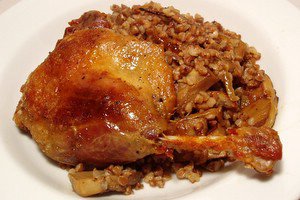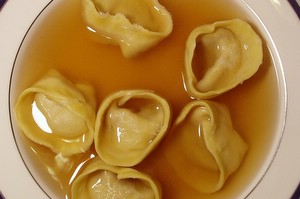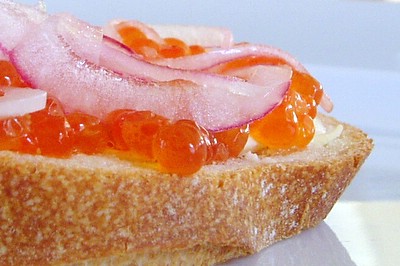 I still remember the first time I tried caviar -- it felt like a dozen little bubbles bursting against the roof of my mouth, each one squirting the creamy, gooey liquid. The rich saltiness rolled in like a big sea wave. Mmmm – caviar. I was 7 and lived in Moscow, and it was the first time I was allowed to stay up until midnight and celebrate the New Year with the grown-ups. The table was teeming with zakuski – sturgeon, ham, pickled mushrooms, liver pâté, and herring in fur coat of shredded beets and potatoes. But the most tempting and anticipated dish was the caviar. Its little jar sat on the table like a jewelry box with bright orange beads. It was passed around along with bread and butter for everyone to make a little open-faced sandwich before toasting the passing year and wishing it farewell.
I still remember the first time I tried caviar -- it felt like a dozen little bubbles bursting against the roof of my mouth, each one squirting the creamy, gooey liquid. The rich saltiness rolled in like a big sea wave. Mmmm – caviar. I was 7 and lived in Moscow, and it was the first time I was allowed to stay up until midnight and celebrate the New Year with the grown-ups. The table was teeming with zakuski – sturgeon, ham, pickled mushrooms, liver pâté, and herring in fur coat of shredded beets and potatoes. But the most tempting and anticipated dish was the caviar. Its little jar sat on the table like a jewelry box with bright orange beads. It was passed around along with bread and butter for everyone to make a little open-faced sandwich before toasting the passing year and wishing it farewell.“Eeew, fish eggs” was my American friend’s reaction to my favorite food. “It’s slimy and salty. That’s disgusting.” I didn’t understand how fish eggs were any more disgusting than chicken eggs. Until I came to America at 13, I haven’t met anyone who didn’t like caviar before. Just imagine how an American child would feel if they offered a kid from another country their favorite chocolate bar, and were told that chocolate is disgusting because it is the color of poop. Although my friend’s rejection of caviar was disappointing to me at the time, it made me realize that we taste food with our memories and heritage, not just our pallets. To me caviar tastes not only salty and creamy; it tastes of New Year, of school break, of trying very hard not to fall asleep until midnight, and of proving to the world that I am a grown-up.
Red (salmon) caviar is much more affordable than black. Most people are surprised to find out that $5-7 can buy them enough caviar to serve as an appetizer for 6 people. No need for mother of pearl spoons, or other such fanciness. Good bread and butter is all you need -- that's how most Russians eat it. I usually top red caviar with sweet pickled onions to balance the salty creaminess of the roe.
This recipe is all about ingredients, so here are some tips on choosing the right ones. The plastic tasting Romanoff caviar sold in supermarkets won't do. Go to a Russian store and buy some real salmon caviar. Don't buy the cheaper ones -- they tend to be over-salted and gooey due to broken eggs. Whole Foods carries salmon roe too, but it's twice as expensive as in the Russian stores.
Red Caviar Canapés with Pickled Onions
Serves 6
For Pickled Onions
1/2 cup white wine vinegar
1/2 cup cold water
1 Tbsp sugar
1/2 tsp salt
1 red onion
In a non-reactive container, combine vinegar, water, sugar, and salt. Peel the onion and slice it very thin (1/16") using an adjustable blade slicer like Benriner or a knife. Mix the onion with vinegar mixture, cover, and refrigerate for at least 4 hours, and up to 2 days.
For Caviar Canapés
Vienna bread, baguette, or brioche sliced 1/2 inch thick
2 Tbsp unsalted butter, softened
4 oz red caviar
Spread bread slices with butter. Top with a layer of caviar, and a few slices of pickled onions. Serve with champagne or sparkling white wine.
Happy New Year everyone! I wish you many joyous feasts with the people you love.

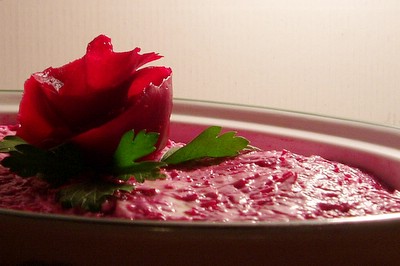
 When looking for a Bouillabaisse recipe in US, you’ll quickly learn that there is a Bouillabaisse police. If they could give out violation tickets for using the name of this holy soup in vain, they would. You used mussels in your broth – $50! You didn’t fly in the appropriate varieties of fish from the Mediterranean -- $100! Hellmann’s mayo for rouille – what travesty – $200!
When looking for a Bouillabaisse recipe in US, you’ll quickly learn that there is a Bouillabaisse police. If they could give out violation tickets for using the name of this holy soup in vain, they would. You used mussels in your broth – $50! You didn’t fly in the appropriate varieties of fish from the Mediterranean -- $100! Hellmann’s mayo for rouille – what travesty – $200!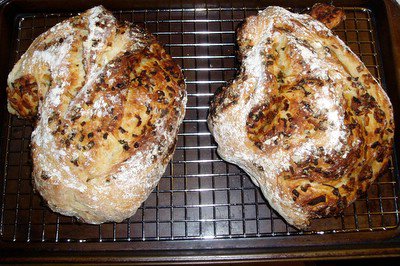 Aren't they beautiful! This is one of the Christmas presents I got from my husband.
Aren't they beautiful! This is one of the Christmas presents I got from my husband. Imagine my surprise when I got kicked out of the kitchen on Christmas eve during the shaping stage of yet another baguette. But what really gave it away, was the "Where is our balsamic vinegar?" question. What could it be? My mind was racing through Reinhart’s book trying to remember what breads used balsamic vinegar (probably in caramelized onions).
Imagine my surprise when I got kicked out of the kitchen on Christmas eve during the shaping stage of yet another baguette. But what really gave it away, was the "Where is our balsamic vinegar?" question. What could it be? My mind was racing through Reinhart’s book trying to remember what breads used balsamic vinegar (probably in caramelized onions).
 In Russia, where I grew up, soup is such an integral part of the culture that people eat it at least once a day. I am not kidding or exaggerating. I must have had soup at least 350 times a year during the first 13 years of my life. Assuming that I didn’t eat grown-up food until I was 2, that adds up to 3,850 soups in a row. Try eating anything 3,850 times and see how you like it. Until we moved to US and broke the must-eat-soup tradition, my attitude to anything that came in a bowl was lukewarm to put it mildly. But even in those days of overzealous soup eating, one soup stood out as special.
In Russia, where I grew up, soup is such an integral part of the culture that people eat it at least once a day. I am not kidding or exaggerating. I must have had soup at least 350 times a year during the first 13 years of my life. Assuming that I didn’t eat grown-up food until I was 2, that adds up to 3,850 soups in a row. Try eating anything 3,850 times and see how you like it. Until we moved to US and broke the must-eat-soup tradition, my attitude to anything that came in a bowl was lukewarm to put it mildly. But even in those days of overzealous soup eating, one soup stood out as special. There is nothing like a good injury to talk some sense into a stressed out workaholic like me. The reason I wasn't blogging for the past couple of days is because I hurt my back and spent the last couple of days either standing or lying down. Neither one of these positions is particularly conducive to typing, though I did try using a laptop while lying down with my legs propped up. It worked long enough for me to send an e-mail to
There is nothing like a good injury to talk some sense into a stressed out workaholic like me. The reason I wasn't blogging for the past couple of days is because I hurt my back and spent the last couple of days either standing or lying down. Neither one of these positions is particularly conducive to typing, though I did try using a laptop while lying down with my legs propped up. It worked long enough for me to send an e-mail to 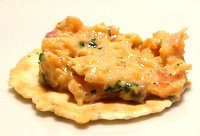 I've been on a salmon binge lately. Yes, yes, I know. I am supposed to be "Beyond Salmon." But the truth is that salmon is a perfect fish to serve cold (so are tuna and sturgeon, but those are a bit of a splurge), and since I wanted to bring some fish appetizer to the Christmas fair at work, I decided on a salmon-orange pâté. This pâté is to salmon like rillette is to pork -- absolutely decadent.
I've been on a salmon binge lately. Yes, yes, I know. I am supposed to be "Beyond Salmon." But the truth is that salmon is a perfect fish to serve cold (so are tuna and sturgeon, but those are a bit of a splurge), and since I wanted to bring some fish appetizer to the Christmas fair at work, I decided on a salmon-orange pâté. This pâté is to salmon like rillette is to pork -- absolutely decadent. I guess I finally found something that chickens do better than ducks -- eggs. As I wrote in
I guess I finally found something that chickens do better than ducks -- eggs. As I wrote in  Poached salmon is such a classic that for a long time I have tried hard to like it. I admit that it's not bad cold, and is really awesome in salmon pate, but as an entree I always found it a bit boring. This could be just me, of course, but I find pot-au-feu (chicken and beef cooked in water) really boring too. What good is all that fat and flavor if you are letting it all drain into the liquid? Besides those two dishes, I like all the other classic French stuff. Really, I do! So I guess I'll stop complaining and get back to salmon.
Poached salmon is such a classic that for a long time I have tried hard to like it. I admit that it's not bad cold, and is really awesome in salmon pate, but as an entree I always found it a bit boring. This could be just me, of course, but I find pot-au-feu (chicken and beef cooked in water) really boring too. What good is all that fat and flavor if you are letting it all drain into the liquid? Besides those two dishes, I like all the other classic French stuff. Really, I do! So I guess I'll stop complaining and get back to salmon. Oh holey crumb! Oh brittle crust!
Oh holey crumb! Oh brittle crust! We got snowed in and like the rest of my office I decided to work from home. As you can imagine I was really excited about spending my commuting hour on making something yummy to eat. The question was what? I was thinking about oatmeal, but as I rummaged through my pantry, I couldn't find any steal-cut oats. But I did find a jar of rolled oats and some sliced almonds. The toasty smell of grannola suddenly filled my imagination. If William & Sonoma made a candle with a "B&B" fragrance, this is what it would smell like.
We got snowed in and like the rest of my office I decided to work from home. As you can imagine I was really excited about spending my commuting hour on making something yummy to eat. The question was what? I was thinking about oatmeal, but as I rummaged through my pantry, I couldn't find any steal-cut oats. But I did find a jar of rolled oats and some sliced almonds. The toasty smell of grannola suddenly filled my imagination. If William & Sonoma made a candle with a "B&B" fragrance, this is what it would smell like. When I entered my office this morning, I couldn't help smiling when I looked at my desk. Next to my computer, a pile of documents, and post-it notes was a dozen of duck eggs! You might be surprised that duck eggs would make an appearance in a software company, so let me tell you the whole story. I met Andrea, one of our developers, at the gym yesterday and found out that she has a chicken and duck farm. Of course, I couldn't I pass up the opportunity to try some duck eggs and I ordered a dozen. Andrea must have dropped them off at my office early in the morning. She is an early riser (being a farmer and all), so she is sometimes here as early as 6am! Not too many software engineers do that :)
When I entered my office this morning, I couldn't help smiling when I looked at my desk. Next to my computer, a pile of documents, and post-it notes was a dozen of duck eggs! You might be surprised that duck eggs would make an appearance in a software company, so let me tell you the whole story. I met Andrea, one of our developers, at the gym yesterday and found out that she has a chicken and duck farm. Of course, I couldn't I pass up the opportunity to try some duck eggs and I ordered a dozen. Andrea must have dropped them off at my office early in the morning. She is an early riser (being a farmer and all), so she is sometimes here as early as 6am! Not too many software engineers do that :)  After spending a bit too much time in the kitchen over the weekend and eating duck and more duck, I was determined to make a healthy 30-minute meal last night. Whole Foods was having a special on pollock this Sunday, so that became yesterday's dinner. Pollock is a mild white fish similar to haddock or cod, so it needed a little help in the flavor department. Some olive oil, rosemary, garlic, and tomatoes came in handy. A quick sear in the pan before finishing it in the oven crisped the outside and gave it more oomph, but if you wanted to make it a one pot dish, you could skip the sear and simply bake it.
After spending a bit too much time in the kitchen over the weekend and eating duck and more duck, I was determined to make a healthy 30-minute meal last night. Whole Foods was having a special on pollock this Sunday, so that became yesterday's dinner. Pollock is a mild white fish similar to haddock or cod, so it needed a little help in the flavor department. Some olive oil, rosemary, garlic, and tomatoes came in handy. A quick sear in the pan before finishing it in the oven crisped the outside and gave it more oomph, but if you wanted to make it a one pot dish, you could skip the sear and simply bake it.